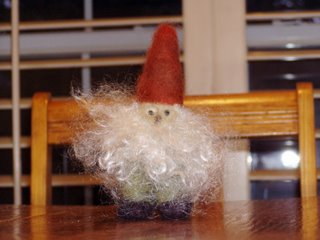I've owned Anna Zilboorg's hat book for about 8 or 9 years now, and I decided the time was ripe for me to knit one of the hats. Since the book had been out for quite a while, I even checked the publisher's website to see if any errors were listed. There was no mention of the book at all. So I started knitting one of the hats (Egyptian Hat #3).
A couple of things didn't quite make sense to me, so I emailed the publisher. I got a quick reply, saying, "What's your address -- we'll send you the corrected charts."
In retrospect, perhaps I should have set the hat aside at this point.
But it was going quickly and I needed a travel project, so I just kept knitting. I did wonder about the design -- why on earth would you have all that blank space in a stranded knit project? why did I have to do so much weaving in? -- but hey, I can do that.
And I did wonder about the end of the chart, where it looked like I would suddenly decrease 8 out of 9 stitches, all the way around. Perhaps it was a gather? I hate gathers in the crown of a hat or the tip of a mitten, but I was trying to knit Zilboorg's hat, not my interpretation of what I thought she was getting at, so I'd follow directions (this time at least) and see what I thought when it was done.
Besides, since the directions and the charts are separate from each other, I thought that the finish would all make sense once I sat down and really read the directions.
Four rows from the end (the center of the crown) I did sit down and really read the directions. And look at the chart. And look at the hat. It didn't make sense, and I could no longer deny that something was Really Wrong:

Blocking cures a lot of woes, but this is just not a flat-topped hat.
So I went to bed.
In the shower this morning it all suddenly came together. The chart was wrong. All that tedious blank space wasn't meant to be there. All that tedious weaving in was unnecessary. The decreases on the right hand side of the chart should have been mirrored by decreases on the left hand side. Then the inexplicable instructions about a double decrease would suddenly make total sense. All is clear.
I'm really quite embarrassed that it took me 18 rounds to figure this out. But I'm even more annoyed that the PUBLISHER or perhaps the EDITOR or even the AUTHOR didn't notice that three out of the 5 charts in this chapter of the book are missing half their decreases. If it had been only one, I think I would have figured it out sooner. But I looked at those other erroneous charts and thought, "Well, it looks like she uses that weird ending quite a bit -- I guess it will make sense when I get there." Wrong.
Gotta go -- I have a hat to rip out.


































